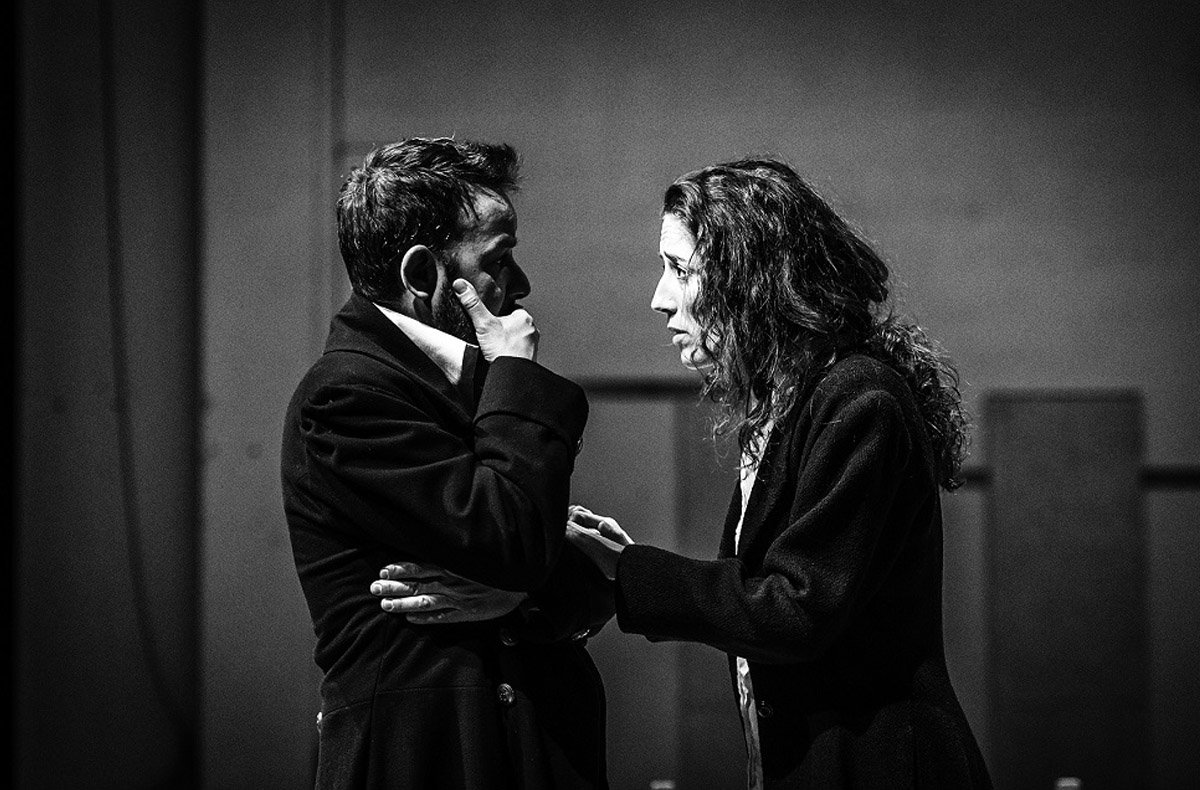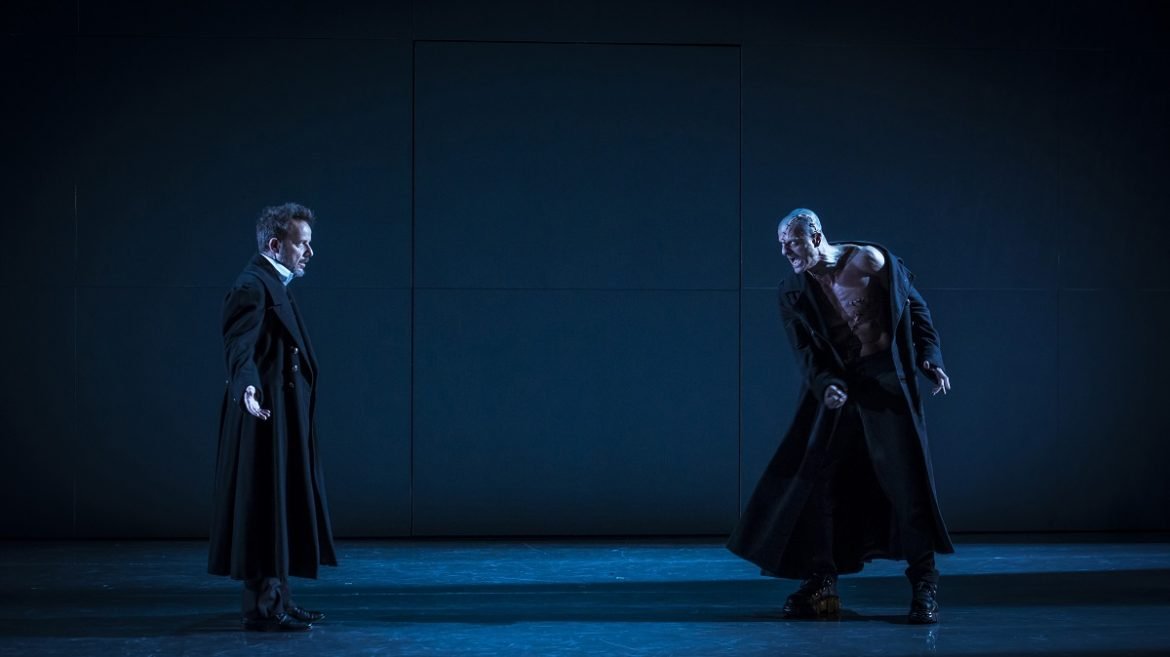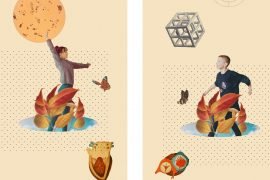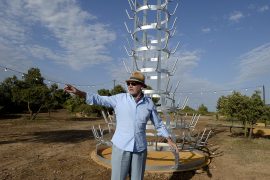Heartless, rational, sober, histrionic, empathetic, disconsolate, hopeful, positivist and nihilist, overly explicit and at times subtle. As captivating as it is repulsive in the exaggeration of the disjointed gestures that characterise the featured creature. The supposedly enlightened discourse proffered by its creator sounds equally contradictory, as he curses his artificial reality ipso facto, without leaving any room to celebrate life. Thus is the version of Frankenstein by Guillem Morales, directed by Carme Portaceli, and now showing at the Teatre Nacional de Catalunya.
The play stars Joel Joan and Àngel Llàcer in memorable performances. It seems to seek hand-to-hand combat; it overpowers the viewer with a battery of questions signalling the times, which nonetheless reveal atavistic fears, disquiets that are timelessly valid and inherent in human beings: the need to ease the indifferent action of nature. Especially those manifestations that threaten human integrity yet are beyond the control and stability of rational consciousness, the organ in sapiens sapiens which promotes self-conservation and enables it to artificially create a second nature.
THE MODERN PROMETHEUS
The reference to the “modern Prometheus”, which Mary Shelley conceived based on the spine-chilling evenings she shared with other celebrated literati who were fully ensconced within the movement that came to be known as Romanticism, is aimed less at the monster and much more to the scientist who dreamt him up, whose perfect mirror image he represents, Dr Frankenstein. The staging at the TNC addresses the issue in medias res: the yearning to escape death, to control and perpetuate life through technology are the modern version of this founding act in the development of civilisation, namely Prometheus’ mythical act of stealing fire to give it to humans.
It is known that this Titan, a champion of mankind, had to pay dearly for his boldness, which the Greeks called hubris. Man’s emancipation and elevation above nature – as a mere animal determined by it – sparked Zeus’ wrath, so he decided to chain Prometheus to a rock and subject him to the torture of being devoured by an eagle, specifically his liver, which regenerated by the end of the day so that the torture could be repeated the next day. We might think that the punishment that comes from rebelling against the divine designs, or against the usual order of nature, is subtler in the modern version of the myth. But it isn’t really.
THE SCIENTIST AND HIS SHADOW
Neither Shelley nor some of the earliest versions of Frankenstein’s monster – and of course, not the current one either – bring much mellowness to the matter, leading one to understand that the origin of evil does not lie in the obscene reality of the artificial creature, which indeed terrorises us with his scars and unusual proportions. Evil is instead experienced as constitutive; it pulses inside whoever needs to understand their own nature through the artificial act of bringing to life, in a laboratory and thanks to electrical charges from lightning, that other being which is only apparently unlike him.
One of the most powerful devices in the version of the myth of Frankenstein starring Joel Joan and Àngel Llàcer – in the role of the monster and the doctor, respectively – lies precisely in the reciprocity and complementarity of their stories, which even take place simultaneously onstage. Other times, they also happen successively and are linked together via eloquent parallelisms.
This concatenation is stressed through a wonderful stage device: a conveyor belt unwittingly carries the actors towards the stage left, giving rise to another reality, the same one, in fact, that brings together creator and creature. The ingenuity of the recently-born creature contrasts with the enlightened cynicism of the scientist, who wields his knowledge to serve instinct. Just as another fictitious investigator from the same century, Dr Jekyll, will do to create an untethered life, the horrifying creature that he himself becomes via a concoction: Mr Hyde.
INVERTED CELEBRATIONS
Far before that omega of such decadent plenitude, and still on the dawn of modernity, in a text that has become the manifesto of humanism, Discourse on the Dignity of Man, Giovanni Pico della Miradola celebrated the distinction between the human being and the other animals: a creature himself, true, but one created with an incomplete nature. This nature is endowed with the capacity to complete and freely determine his own being, either by lowering himself to the semblance of beasts or raising himself above materiality.

The celebration of this hybrid, chameleon-like disposition seems to ignore the less luminous facet of human behaviour, and, of course, how by thinking, which is – in theory – purifying, man also seeks to promote and satisfy his basest instincts. The instinctual and the rational, which seem to be antithetical principles a priori, are not mutually exclusive in human beings. As an impenitent, profoundly anti-system thinker would later reveal, they conspire in strange and unpredictable ways. This point accentuates this interesting take on Frankenstein, as it confuses and extrapolates the attributes of the creator and creature.
The doctor’s arts fashion a second nature, which at first is unconscious of itself and perfectly ingenuous. The horrifying image which is projected by Joel Joan, exuding disturbing expressiveness, is nonetheless candid, while the manners and impeccable education of the scientist, embodied by Ángel Llàcer, ooze falseness. His actions are unquestionably serious, and his attempt to subvert the comical register is meritorious, because he is more famous. The ambiguity of the meta-fiction also reveals the magnificent talents of the star and is placed at the service of the plot.
CLARIFYING THE EMPTY DISCOURSE
The character of the scientist is driven by the need to contain the inexplicable death of his mother when she was giving birth to his brother; this leads to the exacerbation of technological development, to the mortal leap of the maximum conceit which will ultimately be his downfall. The tyrannical determination of the fatum – a profoundly romantic notion which can also be found in a more primitive form in the Greek notion of ananke, the invisible thread that ties moirai together – is masterfully enacted through that simple stage device which enlivens events and incites perplexity in the spectator. The scientist’s actions seem to follow that sinister aphorism by Franz Kafka, “I am a cage, in search of a bird”. He rushes headlong into a curse caused by the invention which was precisely supposed to solve his original distress.
The monster learns how to speak and think: from barbarous babbling he comes to utter Hamlet-esque reflections for which the scientist has no answer. And when he does, he is not capable of rising to the occasion: the fact that in nature there is no cruelty nor beauty, neither good nor evil exist, but indifference reins – proclaims the doctor – is something that he himself has not yet internalised, hence his tendency to create an artificial life to complement and repair the traumas inflicted by more natural life. This indifference that Lars von Trier shamelessly displays in the revulsive and blinding Antichrist can be glimpsed in the production of the Teatre Nacional.
Yet unlike what is captured on film, in the theatre version (of the problematic mending of the iniquity suffered by the main character), what we eventually find is an excess of discourse. A plethora of words, and very elaborate ones, which when declaimed sound high-flown yet hinder this same elaboration in the spectator. They minimise the anguish that an empty discourse with completely a-rational meaning should arouse. The discourse that does not allow itself to be understood and which should show itself in that light.
LAUGHTER AS TANGENT
The shift is gradual but quite evident, revealing the transformation of the scientist into a beast and the beast into scientist. In this sense, the poster that advertises the play – hyper-symptomatic in its specular depiction of both characters, with scars – is a total and complete spoiler. The performances of the supporting actors are quite convincing, more contained than the starring duo, creator and creature, united by a common fall from their characteristic innocence due to their lack of understanding of what they are victims of, which they abet with unconcealed poignancy. It is a solemn, tragic function which also carves out space for laughter. Thaumaturgic laughter, for example, in the unformed, likeable monster’s course of learning, and his request to also have a partner assembled from parts (such as in the 1935 film Bride of Frankenstein, the sequel to the mythical film which also starred Boris Karloff and was directed by James Whale).
Yet also – and even more interesting – it gives rise to hysterical laughter given the margin of corruption that characterises it, just like any natural being. This is the laughter that feels out of place, fostered precisely by that thing that causes dread, in the familiar presence of the sinister. Atavistic fears are represented with scant yet effective means, and they are particularly illustrated with endless expressions by the monster despite himself, as embodied by Joel Joan. It is difficult not to empathise with that being who reflects incomprehension and injustice. It is even more complex to understand the need that the rational mind of our species harbours to create it, as in the good Dr Frankenstein, to embrace technological artifice as a solution to the instinctual dimension, which is simultaneously repudiated.




















